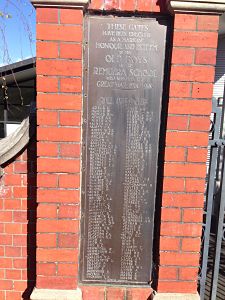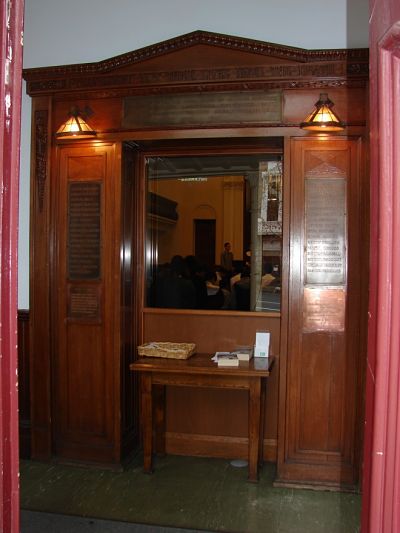WW1 Blackie Brothers — Bernard Blackie 6/3252
Bernard (6/3252) 11 April 1893 – 8 June 1918
Walter Palmer (6/3253) 11 May 1894 – 31 October 1980
Owen Campbell (6/2937) 2 June 1884 – 20 November 1918
Allan Stuart (12/878, 1/484, 834025) 7 September 1892 – 26 November 1946
Henry George Blackie (1857- 8 April 1916), a Baptist missionary and tea dealer, and his second wife Louisa Rose Blackie (nee Murphy (3 March 1858 – 17 June 1923), married in 1878 and had seven children, four sons of whom served in World War I.
In Tasmania, Australia, another son, Allan Stuart Blackie was born in 1892. Whilst in Melbourne, two more sons were born – Bernard Blackie in 1893 and Walter Palmer Blackie in 1894. Subsequently the family moved to New Zealand where all four sons enlisted in Christchurch for active service.
Henry George Blackie died on 8 April 1916 and at that time Louisa Rose Blackie’s address was 3 Great North Road, Grey Lynn, Auckland. Louisa died on 17 June 1923 and is buried in Hamilton.
Bernard and Walter Blackie are commemorated on the Remuera Primary School gates, although it is not known when they attended or whether they lived in Remuera.[IR: 1]
Brothers Bernard (Service number 6/3252) and Walter Blackie enlisted together on the same day 24th August 1915 in Christchurch. Bernard was born in Melbourne, Australia on 11 April 1893. He was an engineer, apprenticed to P. and D. Duncan, Agricultural Machinery Manufacturers, in Christchurch and was described as 5ft 4 3/4 inches tall, with blue eyes and a fresh complexion. [1]. He lived at 34 South Crescent, Christchurch. He and Walter sailed on the Monowai from Christchurch to Wellington. The Sun newspaper reported on 24 August 1915 that “the ferry wharf at Lyttelton was packed with a huge crowd, and the men of the 8th received a very enthusiastic send-off. The Boy Scouts, Sea Scouts, and the local unit of the Citizens’ Defence Corps, accompanied by the Lyttelton Band, were in strong force, and patriotic airs were played by the band.” [2]
Bernard and Walter embarked together on 13 November 1915 from Wellington on the ’Williochra’ (HMNZT35) via Suez for Egypt in the New Zealand Machine Gun Corps, 2 Company, 8th Canterbury Infantry Battalion, Bernard Walter disembarked at Suez on 20 December 1915. The three brothers all took up machine gun work and for a considerable time were fighting side by side in the same section. In a letter in 1916, Bernard stated that he was doing well, though, with the exception of five day’s rest, had been in the trenches for over three months. [3].
Bernard and Walter were both in action at the Battle of Messines. In June 1917, the New Zealand troops were battling on the Western Front. The carefully prepared attack on Messines in Belgium was a striking success. At 3.10 a.m. on 7 June 1917 huge mines that had been placed under the German lines by hard-working New Zealand tunnellers exploded. Almost immediately, New Zealand troops of the 2nd and 3rd (Rifle) Brigades left their trenches and advanced towards the ridge in front of them, on which lay the ruins of Messines village. Australian and British troops moved forward on their flanks. All the while, the gunners battered the enemy front line, as well as searching for and neutralising German artillery batteries. The New Zealanders paid a heavy price for success. By the time the New Zealand Division was relieved on 9 June 1916, it had suffered 3700 casualties, including 700 dead. [4] Bernard was killed in action in the field on the 8th June 1917. His brother Walter was wounded on the same day. [5]
Bernard Blackie is remembered at the ‘Messines Ridge (New Zealand) Memorial to the Missing’ which is situated within Messines Ridge British Cemetery, Messines (now Mesen), Belgium. [6], [7]. His name is also listed on the Remuera Primary School Gates. A British War Medal awarded to him posthumously, was sent to his mother in September 1921. A memorial service was held for him and many others in Sydenham Baptist Church, Christchurch on 3 December 1916.
He was also honoured at the Auckland Baptist Tabernacle, in Auckland on 23 June 1917. Sir Theodore Cooper, of the legal firm of Devore & Cooper, unveiled a memorial door and lamps at the Auckland Tabernacle on 4th August 1921. On either side of the door there are two illuminated brass tablets listing the names of 33 men who had died, including Bernard Blackie. The following text was inscribed on the architrave: “They loved not their lives unto the death”. Beneath this was a plaque with the dedication: “To the glory of God, and in living memory / of the heroic sacrifice of those who / fought and fell in the Great World War / 1914 – 1919”. [8]


